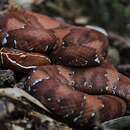pt-BR
nomes no trilho de navegação


Agkistrodon russeolus, commonly called the Yucatecan cantil,[3] is a venomous pit viper species[4] endemic to the Yucatán Peninsula in Mexico and northern Belize.[2]
Adults of A. russeolus may grow to a total length (including tail) of more than 100 cm (39 in). Gloyd and Conant (1990) reported that the largest specimens they saw were from Pisté, Yucatán: a male of 105 cm (41 in) with a missing tail tip and a female of 101 cm (40 in). The average tail length is 19.2% of total body length in males and 16% in females.[3]
Scalation includes 23 rows of keeled dorsal scales at midbody; 131-141 ventral scales; and 46-62 subcaudal scales, most of which are paired, especially towards the tail tip.[3]
The dorsal color pattern consists of light brown to deep reddish brown ground color overlaid with 12-18 broad brown or brownish crossbands. Laterally, these crossbands are more lightly colored in the center and usually contain one or two dark spots. The head is clearly marked on either side with two longitudinal light lines: the upper one is narrow and may be broken behind to the eye, while the lower one is wider and separated from the commissure by a dark band.[3]
Mayan names for A. russeolus are wol-poch (Gaige, 1936) and uol-poch (Schmidt and Andrews, 1936).[3]
Agkistrodon russeolus occurs on the Yucatán Peninsula. The type locality is "11.7 km north of Pisté, Yucatán, Mexico."[5]: 328 p. The majority of records are from the semi-arid northern regions of the peninsula in the state of Yucatán, Mexico. However, several additional records are scattered in the south at various isolated localities in the Mexican states of Campeche, Tabasco, the vicinity of the Quintana Roo and Belize border, and northern Guatemala.[3]: 60 p. [6]: 61 p. [7]: 399 p. [8] A number of reptiles from the Yucatán Peninsula fit this pattern of distribution, with continuous and unbroken records in the north, and several isolated and disjunct populations in the south.[9]: 32-33 p.
Northern areas of the Yucatán Peninsula support a predominantly low, deciduous scrub forest (Yucatán dry forests) with thin soils on a porous limestone karst landscape. Surface water is uncommon or absent in the region.[3]: 84 p. The vegetation zones in the north have been characterized as tropical deciduous forest attaining heights of 20 meters in some areas, and thorn forest 5-7 meters high that is impenetrable in places in the far north. Southern regions of the peninsula, including much of the states of Quintana Roo, Campeche and northern Belize and Guatemala (northern El Petén) sustain tropical evergreen forest averaging 25-30 meters high. The canopy may be closed in some areas with a dense understory of vines and shrubs or more open in other areas allowing light to the ground.[7]: 9-10 p.
Agkistrodon russeolus, commonly called the Yucatecan cantil, is a venomous pit viper species endemic to the Yucatán Peninsula in Mexico and northern Belize.
El cantil yucateco (Agkistrodon russeolus) es una especie de serpiente venenosa que pertenece a la subfamilia de las víboras de foseta.[2] Su área de distribución incluye México, Belice y Guatemala.[3]
En A. russeolus la raya facial superior es estrecha y algunas veces es intermitente posterior al ojo, y la raya inferior es más ancha y continua y separada de la comisura por una banda de un pigmento oscuro. Desde una vista frontal, la raya vertical a lo largo de la rostral y mental y las dos rayas superiores laterales de la cabeza típicamente se unen en la punta del hocico. El color dorsal de fondo de los adultos es generalmente café rojizo pálido y el patrón consiste de bandas cruzadas café rojizo profundo a café que están separadas dorsalmente por áreas de coloración más clara y que frecuentemente están bordeadas irregularmente por color blanco. Las bandas cruzadas permanecen evidentes incluso en adultos viejos. Lateralmente los centros de las bandas cruzadas son más pálidas y usualmente contienen uno o dos manchas oscuras.[4]
Se distribuye en la Península de Yucatán y el norte de Belice. Recientemente ha sido reportada para el estado de Tabasco, México.[2]
Habita en selva mediana subperennifolia
Esta especie ha sido considerada como relativamente rara en la península de Yucatán sin embargo es lo suficientemente común para ser enlistada como la tercera causa más frecuente de accidente ofídico en la región, después de Bothrops asper y Crotalus simus (Ahora C. tzabcan).[2]
IUCN: No enlistada sin embargo un reciente estudio propone que sea considerada como amenazada.
El cantil yucateco (Agkistrodon russeolus) es una especie de serpiente venenosa que pertenece a la subfamilia de las víboras de foseta. Su área de distribución incluye México, Belice y Guatemala.
Agkistrodon russeolus Agkistrodon generoko animalia da. Narrastien barruko Viperidae familian sailkatuta dago.
Agkistrodon russeolus Agkistrodon generoko animalia da. Narrastien barruko Viperidae familian sailkatuta dago.
Agkistrodon russeolus est une espèce de serpents de la famille des Viperidae[1].
Cette espèce se rencontre[1] :